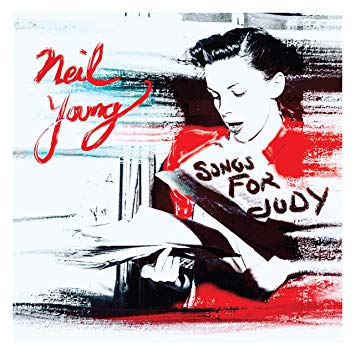by David Haynes (@shooshlord)
Artists have to live with the legacy of their past work. If you have ever been to see an older indie rock band, you will likely hear a number of folks screaming for their 1994 “hits.” Neil Young begins his newest archived collection of live recordings from 1976, Songs for Judy, by ranting at the “loud, boisterous mothers” for yelling out requests for his older songs. And then, he obliges them a gorgeous, moving, and sometimes strange set that contains material spanning his entire career.
The songs here are not unfamiliar. In fact, many of these exact recordings have been circulating in a popular bootleg known as The Bernstein Tapes. But this might be the first time that Young has acknowledged that these recordings are worthy of release. Songs for Judy begs the following questions: why these songs, and why now?
1976 was not the easiest time to be Neil Young. He had just released Tonight’s The Night, a shaky and powerful tribute to two close friends of Young’s that had died of drug overdoses. In the liner notes for Tonight’s the Night, Neil wrote, “I'm sorry. You don't know these people. This means nothing to you.” And I think that spirit of grief and anger haunted the 1976 tours. Certainly, it haunts the recordings found on Songs for Judy.
But amidst all the pain and turbulence of this time in Young’s life, there are some truly beautiful moments here. It’s incredible to hear an artist working out their new and unreleased material. The album opens with “Too Far Gone,” which at that time had not yet been released. You can hear the sadness and regret when he sings “And I don’t know how we made it home” knowing that some of his friends didn’t make it back alive. Similarly, “Roll Another Number” sounds especially melancholy without the harmonies during the chorus. He plays a transcendent version of “Pocahontas,” a song that would later be released on 1979’s Rust Never Sleeps.
I usually think of Neil Young as a guitar player first and foremost. But, the piano performances on Songs for Judy are absolutely stunning. “Journey Through The Past” is especially beautiful stripped down to just piano, voice, and harmonica. “After the Gold Rush” has always been one of my favorite Young songs, and the version here is remarkable. It captures exactly what the original recording does; this profound sense of loneliness. He introduces it by saying, “Listen, I’d like to do this song for all the freeways here in Texas.” Somehow, I just imagine Neil having written on a long drive through Texas on a dry, cool night. It’s moments like this that remind us that Young is a truly cinematic writer, able to capture landscape and emotion somehow simultaneously.
Despite the introduction where he talks about hating the songs he has to play over and over again, he plays many of the popular selections from Harvest and other previous albums. The version of “Heart of Gold” sounds rushed and desperate, as if Neil is upset about playing the song but still decides to give it his all. “Harvest” is brilliant as ever in this raw performance. But, perhaps my favorite selection from Harvest is “The Needle and the Damage Done.” His voice sounds weak and trembling as he sings, “But every junkie’s like a setting sun.” Harvest has often criticized by hardcore Young fans for being too polished. The versions here remind us that the songs that make up Harvest are just as sad and poignant as those found on Tonight’s The Night or On The Beach.
And there are some truly odd moments on Songs for Judy. The banjo is a bizarre choice of instrument for this solo version of “Mellow My Mind” from Tonight’s The Night. The banjo is maybe the most un-mellow instrument, and that clash between Young’s softer voice and the clanging banjo makes for an interesting listen. On “A Man Needs a Maid,” he switches between a big synthesizer and piano. I guess he was trying to make do without a string section at his command, but the result sounds like two different songs jammed together. At the end of “Old Laughing Lady” where I think he sings through the harmonica trying to mimic the sound of an old lady laughing or a cat about to cough up a hairball. Either way, it sounds weird as hell.
So, this brings us back to the original questions: why these songs, and why now?
The greatest thing about Neil Young records, particularly those of the mid-70s, is they are full of what are technically “mistakes.” Fudged notes and strained vocal cords are all over Tonight’s the Night and Zuma, making them some of the most human records ever made. It’s just sweaty, gritty rock and roll without any pretense.
Songs for Judy manages to capture Young at maybe his most vulnerable, most heartbroken, and maybe most human. He’s recovering from the unbearable tragedy of losing two close friends. The grief is still there, and it is almost palpable in these performances. While Neil was most certainly a great songwriter, I think he was probably an even better performer. For a younger generation of listeners, Songs for Judy gives us a fresh perspective on Neil Young’s live persona and reminds us why he is so revered and loved in rock and roll canon.

